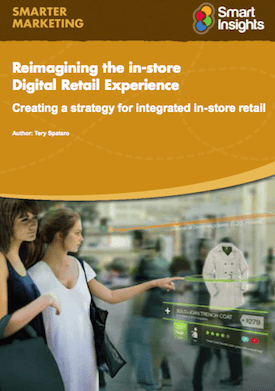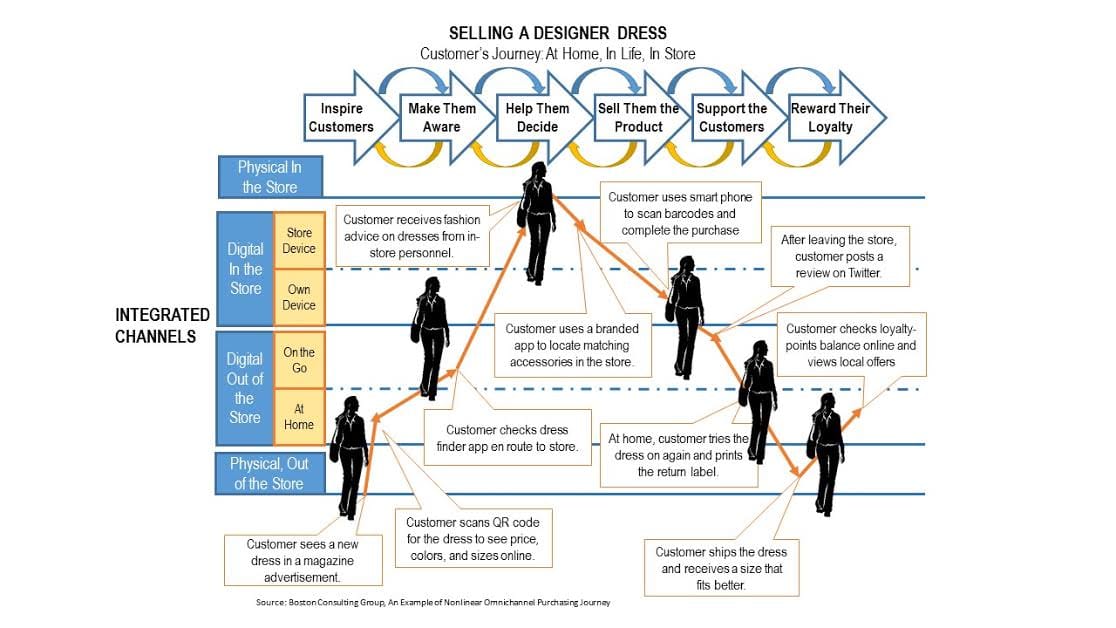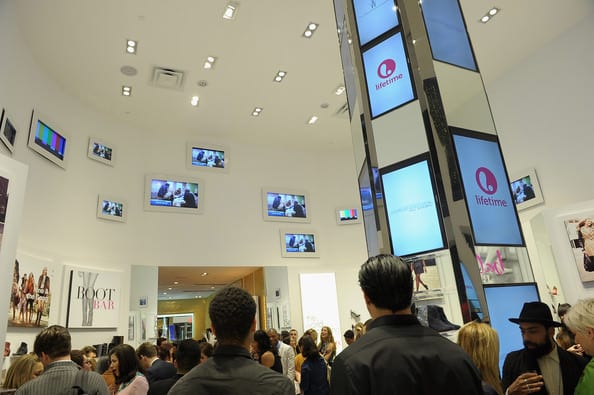Creating a strategy for integrated in-store digital retail
'Consumers are 'center stage' in their relationships with retailers. The idea that a bricks and mortar store can simply 'pile it high and sell' are increasingly waning. The in-store experience needs to compliment and work with the ecommerce experience by adding a sense of magic and hyper personalization that is so perfect to each individual that it can't be found elsewhere. Retail needs to be the theater!'
Nelson Freitas, Chief Strategy Officer, Wunderman.
Digital technologies inspired new visions for the future of stimulating engagement with retail customers while helping customers move along their purchasing journey. Initially Ecommerce left some retailers scratching their heads on what to do, with many questioning whether the Internet was just a fad. Although the growth of online retail ecommerce sales has been steady, it currently lies at just 8% of all retail sales in the US. To safeguard against the potential risk of the Internet being just a fad, some marketers chose to treat ecommerce as a separate sales opportunity rather than risk integrating ecommerce with brick and mortar.
Digital entrepreneurs took another route, building elaborate online malls that catered to a customer’s every need without customer ever needing to go to a physical location – hence the customer is saving more time and money. Gradually, adoption and acceptance of retail ecommerce took over.
With Ecommerce retail sales still pegged at less than 10 percent in many countries, there are great opportunities for integrating digital technologies in-store, particularly since they can support the consumer showrooming behaviour. So today, we are observing yet another technological shift in the retail experience. Mobile inspired customers are on the go make easy online transactions. This inspiration has led to forward-thinking devices like Square and eliminating clunky cash registers that take up retail space.
These technology shifts have caused great disruption but have also led to innovation. The customer that is demanding the most from these technological shifts is the Millennial customer. They are telling us what to expect from upcoming generations. As retailers, we need to prepare and think about both the short-term and long-term future of retail.
Today we are living in an incredibly challenging and exciting time for retail. The changes that digital technologies have created are providing retailers with opportunities to know their customers, create deeper relationships, and lower the friction of the connection through a seamless omni-channel.
I have recently written the new Smart Insights Guide on the digital future of retail where I show how to plan the best integrated experience with examples of who is doing it well.

Recommended Guide: Creating a strategy for multichannel retail
Learn how to review customer journeys and deliver the best customer experience using in-store digital technology.
Download our Re-imagining in-store retail guide.
In this post I will outline the 7 steps covered in the guide.
Step 1: Analysis to uncover opportunities and challenges
First, we review the top challenges facing retailers, overview the latest trends in in-store digital technologies, and discuss assessment tools that will help you uncover your retail situation analysis and identify the business problem and brand challenge you may be facing. We will examine how your competitors are using digital experiences in-store and identify the behaviours your customers are using with digital.
Templates and tools will be provided to help you with your situation analysis.
- Taking stock of your retail store and competitors' use of digital
- Cheat sheet for observing your customer’s in-store use of digital
- Customer journey analysis
- Stacking up against your competitors positioning map
- Defining business problems, brand challenges and solutions
After uncovering the challenges of your retail business and brand, we will identify opportunities, and help envision a new vision for using digital in-store.
Templates and tools are provided to help you align the business problem and brand challenge.
- Examples to help alignment of your business and brand
- Envisioning the omni-channel as an ecosystem
Step 2: What do your customers need?
Now that you have assessed your business and brand, you will need to understand your customer’s needs, identify top needs of customers before, during and after shopping; frame the customer journey from home, life and in-store; identify the behaviour of your customer and their needs against the needs to your business and brand objectives. This alignment provides you with a perspective so that you can examine your customer’s use of the digital technologies.
Templates and tools will be provided to you help you identify your customer’s behaviours and needs and illustrate their use of digital in home, in life and in-store.
- Shopping personas
- Technograph template
- Digital and social media assessment
- Customer journey mapping
Step 3: Define the retail digital experience
Now it all leads up to this moment – your experience plan! The culmination of your findings will point to the experiences your customers will appreciate in your retail store.
We will provide a template that will help you build your experience plan.
Step 4: Your customer’s multi-journey
The customer is focused on the journey to purchase; as a retailer we can help them get what they need. One of the most important strategies for retail stores is the conversion strategy. In this section we discuss the different strategies to put in place to lower omni-channel friction and to make a connection with your customers to help them with their path to purchase.
Designing multichannel journeys – how does to design journeys integrating from:
- Offline advertising
- Desktop/tablet website integration
- Mobile/smartphone integration
- In-store purchase
Step 5: Designing to retain
Retention is just as important as conversion. Here we will explore different relationship development methods through content, apps, and devices to engage your customer and bring them back in store. We will cover best practices and case studies.
Our assessment tool will help identify the components you will need to design and deploy the digital experience for your store.
Step 6: Performance, tracking and evaluating
Tracking the performance of your in-store experience is extremely important. This section will discuss the key performance indicators (KPIs) and alignment of the KPIs to your objectives. Provided will be a framework to examine tracking and evaluation of the performance of your digital experience. Also, included will be a discussion on dashboards that can be integrated into your digital experience to help you track and evaluate.
- Chart illustrating top KPIs for in-store and level of complexity
Evaluation template Boston Consulting Group - An example of the non linear omnichannel purchasing journey.

Step 7: Refreshing
Maintenance is big part of satisfying the customer’s need for newness. Managing and updating content will help you meet the needs of your customer, brand and business. In this final section we will discuss the upkeep of the in-store digital experiences.

Nine West Flagship Grand Opening by Josiah Hobson for Creative Realities.
 Thanks to Tery Spataro for sharing their advice and opinions in this post Tery is widely known for helping brands understand the role technology plays in marketing, innovation and retail environments. Wielding over two decades of experiences in marketing as a digital strategist, Tery takes a deep look into understanding why, what and who. She’s created tech marketing strategies for automotive, food and beverage, consumer packaged goods, education, energy, entertainment, health care, insurance, pharmaceuticals, non-profits and retail brands. Tery has brought digital to life in physical space, having worked with Bloomingdales, Michael’s craft stores, Sally Hansen, Novartis, Whole Foods and Nine West. You can connect with Tery on LinkedIn.
Thanks to Tery Spataro for sharing their advice and opinions in this post Tery is widely known for helping brands understand the role technology plays in marketing, innovation and retail environments. Wielding over two decades of experiences in marketing as a digital strategist, Tery takes a deep look into understanding why, what and who. She’s created tech marketing strategies for automotive, food and beverage, consumer packaged goods, education, energy, entertainment, health care, insurance, pharmaceuticals, non-profits and retail brands. Tery has brought digital to life in physical space, having worked with Bloomingdales, Michael’s craft stores, Sally Hansen, Novartis, Whole Foods and Nine West. You can connect with Tery on LinkedIn.





 Thanks to Tery Spataro for sharing their advice and opinions in this post Tery is widely known for helping brands understand the role technology plays in marketing, innovation and retail environments. Wielding over two decades of experiences in marketing as a digital strategist, Tery takes a deep look into understanding why, what and who. She’s created tech marketing strategies for automotive, food and beverage, consumer packaged goods, education, energy, entertainment, health care, insurance, pharmaceuticals, non-profits and retail brands. Tery has brought digital to life in physical space, having worked with Bloomingdales, Michael’s craft stores, Sally Hansen, Novartis, Whole Foods and Nine West. You can connect with Tery on
Thanks to Tery Spataro for sharing their advice and opinions in this post Tery is widely known for helping brands understand the role technology plays in marketing, innovation and retail environments. Wielding over two decades of experiences in marketing as a digital strategist, Tery takes a deep look into understanding why, what and who. She’s created tech marketing strategies for automotive, food and beverage, consumer packaged goods, education, energy, entertainment, health care, insurance, pharmaceuticals, non-profits and retail brands. Tery has brought digital to life in physical space, having worked with Bloomingdales, Michael’s craft stores, Sally Hansen, Novartis, Whole Foods and Nine West. You can connect with Tery on 


